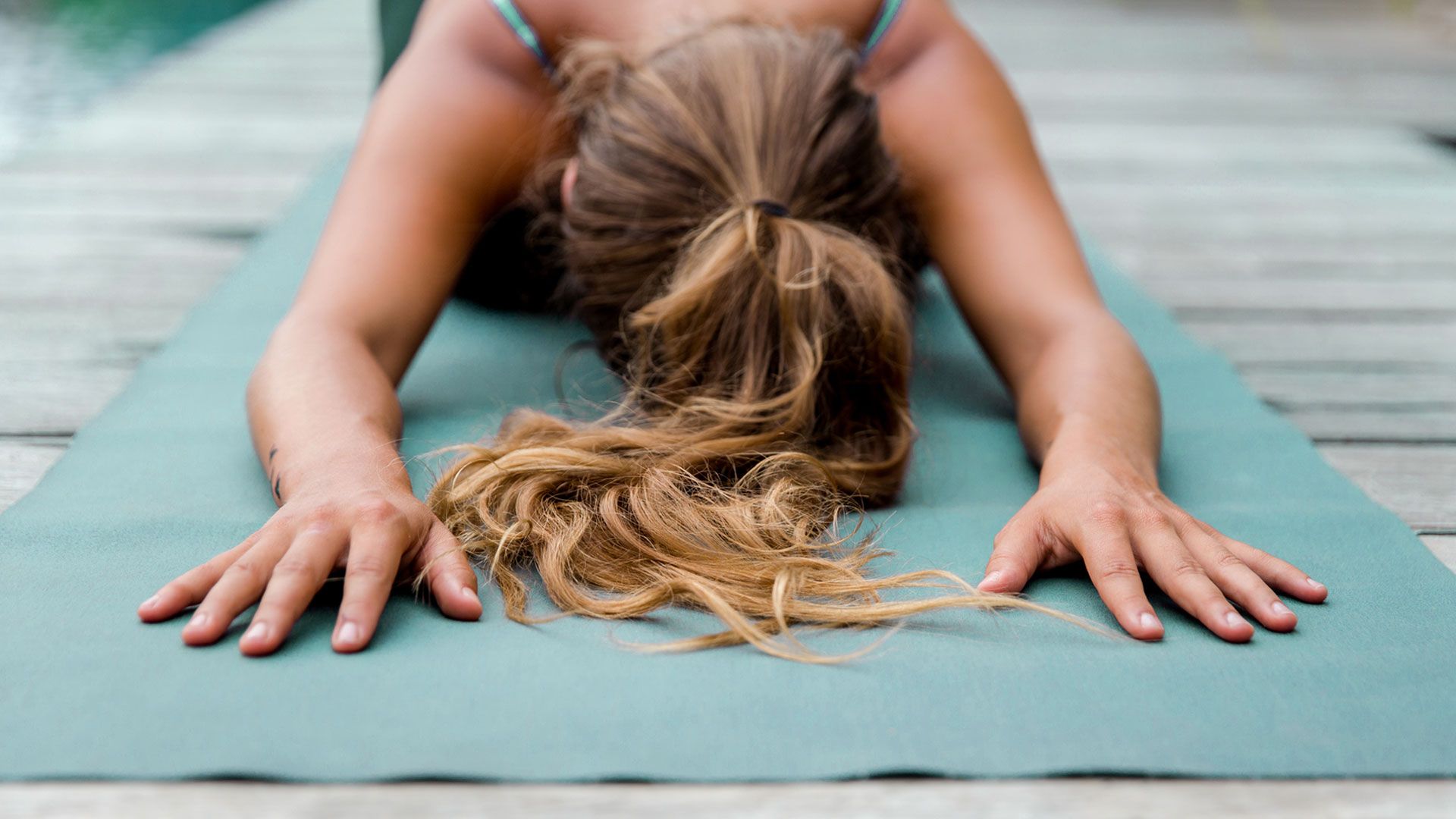Stretching is a powerful exercise — maybe even more than you realize. Find out how the practice can release unresolved trauma from your body and help you heal.
Have you ever stretched before or after a workout? If the answer is yes, you already know that stretching is physically beneficial. What you may not realize is that stretching can do more than prep you for your next cardio session — it can also help you heal from trauma.
According to the National Institute of Mental Health, almost half of all U.S. adults will experience at least one traumatic event in their lives. While trauma is often associated with catastrophic events like military combat, a natural disaster, or physical, verbal, or sexual abuse, it also includes a range of other experiences — such as the death of a loved one, the loss of a job, the breakup of a relationship — leading, in some cases, to post-traumatic stress disorder (PTSD).
While PTSD treatments usually involve psychotherapy and pharmaceuticals, they don’t always address the ways in which the human body can stubbornly hold on to trauma and how psychological distress and physical tension are closely linked.
Yet a report published by the Substance Abuse and Mental Health Services Administration indicates that those who experience trauma are often impacted both mentally and physically. There’s even a significant connection between trauma and chronic health conditions, as research in Frontiers in Psychology shows. Stretching can help immensely, and it’s a powerful practice to have in your toolkit if you need to discharge tension stored in your body.
Keep reading to find out how stretching can help you heal, plus seven exercises to try at home.
Why Is Stretching Important?
“The word ‘stretching’ refers to placing a limb or body part into an extended position, forcing the muscle to elongate for an extended period of time without tearing or breaking,” says Austin Martinez, Vice President of Training and Experience at StretchLab. In other words, stretching is deliberately lengthening a specific part of your body, which offers a laundry list of physical benefits. “It improves flexibility, can reduce muscular tension and enhance muscular relaxation, and promotes circulation, increasing blood supply to your muscles,” explains Danielle DiCamillo, LCSW, a therapist and Registered Yoga Teacher based in New York City.
Just like making healthy eating choices, sleeping well, and taking care of your mental health, carving out time for a stretching program should be a part of everyone’s wellness plan. “Stretching is an excellent preventative measure to have in place to allow your body to age gracefully and maintain a high quality of life,” says Martinez. “Stretching can help similarly to meditation, allowing the mind and body to decompress simultaneously and be still.”
Interested in learning more? Check out The 2-Week Fascia Miracle
How Does Stretching Benefit You Mentally?
While the physical advantages of stretching are well documented, the mental benefits — like increasing your self-awareness — are becoming more recognized. A study published in Perceptual and Motor Skills shows that the act of stretching could help improve cognitive function and mood, while another study from The Journal of Clinical Endocrinology & Metabolism suggests that mindfulness-based stretching and deep breathing exercises could reduce the severity of PTSD symptoms.
Stretching fosters a greater sense of mind-body awareness, making you more conscious of your movements, your breath, and ultimately, how you’re feeling. “Stretching can help someone better understand their emotional landscape that lives inside the body,” says DiCamillo. “It can be helpful in igniting the parasympathetic nervous system, which is part of the autonomic nervous system that’s responsible for feeling more at ease to help improve your sleep, breathing, heart, and digestion, and overall, help you feel less stressed.”
Can Stretching Help You Heal From Trauma?
When a traumatic event occurs, you’re likely unaware of its effect on your physical body, but trauma can indeed impact your physiology. “When someone is faced with a potentially threatening situation, their body’s survival system activates, leading someone into fight, flight, freeze, or submit,” DiCamillo says. Once your survival response is activated, your body immediately stores these emotions and memories, which, over time, can lead to discomfort and distress.
Stretching is a highly effective way to shed that pent-up emotional pain, helping your body to release muscular and fascial patterns of tension, stress, and more. Research published in the Journal of Behavior Therapy and Experimental Psychiatry indicates that you may even feel less sadness. “Stretching can draw on a somatic experience as an entryway into a person’s inner life, as well as build tolerance for discomfort, alleviating tension over time,” explains DiCamillo.
What’s the Emotional Trauma Release Technique?
While stretching isn’t a replacement for therapy or other treatments, you may have noticed a new spotlight on the payoff of trauma release exercises (TRE) on social media. While there are different ways to use this technique, stretching is one powerful method to engage chronically tight areas and address trauma we may have stored in our bodies.
“The emotional trauma release technique focuses on establishing a strong mind-body connection to help facilitate the release of emotional trauma and the resolution of physical symptoms,” says DiCamillo. The approach concentrates on a releasing of “stuck” emotions that could be generating muscular tension within the body.
TRE is designed to safely trigger our body’s natural reflex of shaking or vibrating. “Shaking in this context is the body’s most natural way of resolving contracted or tight stress patterns, bringing the body back to its homeostasis,” says DiCamillo. “Shaking or trembling, which comes from the limbic brain (the part that holds emotions), sends a signal that the danger has passed and the fight-or-flight system can turn off, finishing the nervous system response to release the traumatic experience from the body.”
Simply put, “shaking” is the idea of loosening up, letting go, and literally shaking off the accumulation of tension in your mind and body. These can be done at home (try searching for videos of the technique to learn more) or you can work with a specialist to incorporate them into your self-care routine.
7 Simple Healing Stretches to Try
Ready to start stretching? Here, DiCamillo shares seven yoga stretches to try at home. While they’re not TRE, these healing movements can help the body discharge tension. As you’re stretching, DiCamillo recommends focusing all of your attention on your breath. “Notice the quality of it and any sensation that might arise,” she advises. “If your mind wanders, bring the attention back to your breathing cycle of inhaling and exhaling.”
1. Seated Side Bend
Do this exercise sitting on the floor or in a chair. Either way, make sure your hips are elevated and stabilized. Once you’re seated, walk or reach your right arm toward the right, while stretching the left arm up and over the head toward the right. Reverse sides.
Physical Benefit: Increases the range of motion in the spine, creating more space in the spine and expanding the side body
Mental Benefit: Releases tension from the mind and body and helps to point your attention to your breath
2. Neck Rolls
While seated on the floor, in a chair, or standing, allow your chin to drop toward your sternum to lengthen the back of the neck. Gently tilt the right ear toward the right shoulder to lengthen the left side of the neck. Switch sides. If you’re up to it, make full circles both clockwise and counterclockwise while staying connected to your breath.
Physical Benefit: Relaxes and stretches the neck muscles, alleviating discomfort or tension
Mental Benefit: Decreases anxiety and increases distress tolerance through a subtle sensation in the body
3. Child’s Pose
Kneel and sit on your knees. Lean forward, keeping your buttocks on your heels, and fold your upper body forward. Rest your forehead on something like a yoga block or blankets in order to let your neck relax. Move your arms so they’re next to your legs, palms facing up.
Physical Benefit: Gently stretches your psoas muscles and hips
Mental Benefit: Helps with containment and grounding to decrease emotional overwhelm and encourage self-compassion
4. Standing Forward Bend
Start standing with your feet hip width apart and your upper body hanging over your lower body. Anchor through the feet and slightly bend your knees. Leave your arms and hands free and dangling, or take hold of your opposite elbows. You can hold this yoga pose, which is also referred to as Uttanasana, for about 30 seconds before gently rolling back up to a standing position.
Physical Benefit: Stretches and lengthens the legs and hips; releases tension from the spine to create more space; and vitalizes organs, such as the kidney, liver, and spleen
Mental Benefit: Helps to quiet and calm the fluctuations of the mind
5. Cat-Cow Pose
Get on your hands and knees so your wrists are directly underneath your shoulders and your knees are underneath your hips. On an inhale, arch the spine into a small back bend, reaching the chest forward and up. On an exhale, round the spine, moving your chin toward your chest and dropping your head. Repeat the sequence a few times.
Physical Benefit: Stretches the wrists, hips, legs, and spine, and strengthens the lower abdomen
Mental Benefit: Grounds, centers, and syncs your breath to movement, increasing awareness of mind-body connection
6. Reclined Knee to Chest Pose
Begin by lying on your back. Draw both knees into your chest and straighten one leg out in front. Keep the other leg hugged into your chest. Switch sides when ready.
Physical Benefit: Lengthens the spine and stretches the psoas and lower back while helping to promote healthy digestion
Mental Benefit: Increases feelings of calmness and tranquility
7. Reclined Pigeon/Figure Four Pose
If you’re on TikTok, chances are you’ve seen a hip-stretching exercise on your feed recently. While it’s nothing new, the concept of stretching the hips (thought to be an area that stores a lot of trauma) to release stress is taking off on social media.
In this exercise, begin by lying on your back with your knees bent and feet on the floor, close to the hips. Lift your right knee and bring it close to the chest. Cross the right ankle over the left thigh and flex the right foot. For a deeper stretch, pull the thigh toward your torso and relax your shoulders to the ground.
Physical Benefit: Stretches the outer hips and glutes to release lower-body tension
Mental Benefit: Unlocks the emotional center and helps to alleviate mental stress or worry

